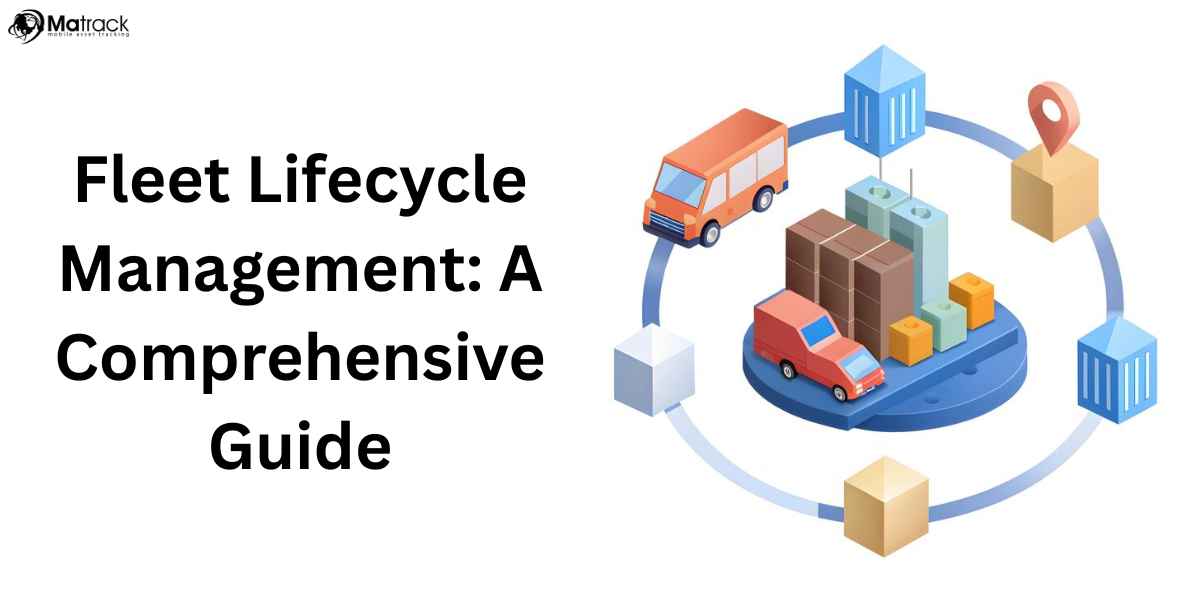Key Takeaways:
- Fleet Lifecycle Management controls vehicle costs and performance through structured phases from acquisition to disposal.
- Tracking key metrics like TCO, utilization, and maintenance ratio improves decision-making and operational efficiency.
- Proactive maintenance and compliance systems reduce downtime, increase safety, and support financial predictability.
- Platforms like Matrack simplify fleet operations by integrating tracking, compliance, and maintenance tools in one system.
What Is Fleet Lifecycle Management?
Fleet Lifecycle Management is the process of managing each stage of a fleet vehicle’s life, from acquisition through to retirement. It helps organizations lower operating costs while increasing how long vehicles remain productive.
This approach ensures every vehicle is used efficiently and maintained at the right time. As a result, businesses experience fewer breakdowns and deliver more reliable services.
The process moves through five key phases which include acquisition, deployment, operation, replacement, and disposal. Each stage plays a vital role in driving performance, supporting sustainability, and controlling overall fleet costs.
Related: What is Vehicle Fleet Management?
What Are the Phases of Fleet Lifecycle Management?
Fleet Lifecycle Management follows a sequence of phases that guide how each vehicle is managed from start to finish. Each phase helps control costs, improve reliability, and maximize value across the fleet.
Vehicle Acquisition
Vehicle acquisition sets the stage for the entire lifecycle by determining cost, performance, and operational fit. Choosing the right vehicles involves analyzing load capacity, distance needs, fuel efficiency, and terrain compatibility.
Ownership decisions—whether to lease, finance, or purchase—depend on the company’s budget, flexibility, and risk tolerance. Planning the correct number of vehicles helps meet business demand without overextending resources.
Onboarding & Integration
Once vehicles are acquired, they must be configured for daily use and aligned with operational standards. This setup phase involves installing tracking systems, company branding, and necessary equipment for safety and comfort.
Drivers receive training tailored to the specific vehicle and its tasks to ensure readiness from day one. Teams also handle all required documentation, including insurance, registration, and compliance checks.
Daily Operation
Daily operation is where vehicles are actively used, so efficiency and monitoring become critical. Telematics systems provide real-time data on speed, location, idle time, and route effectiveness.
Driver performance is tracked using scorecards that evaluate safety, fuel habits, and driving patterns. These insights help reduce risk and improve operational consistency.
Maintenance & Repairs
Ongoing maintenance keeps the fleet in top condition and reduces unplanned downtime. Scheduled service based on mileage or engine hours prevents wear from escalating into major repairs.
Predictive diagnostics detect issues early by analyzing patterns in sensor data and past failures. Logging all repair activities helps identify long-term problems and improves future planning.
Replacement & Disposal
At a certain point, vehicles reach a point where keeping them is more expensive than replacing them. Knowing when to retire a vehicle protects reliability and avoids hidden costs.
Disposal strategies include resale, trade-ins, or reallocating vehicles to less demanding roles. The funds recovered can be reinvested into newer models that offer better efficiency and technology.
Key Metrics in Fleet Lifecycle Management
Tracking the right metrics in fleet lifecycle management gives companies insight into performance, cost control, and timing decisions. These indicators help fleet managers take action before issues impact operations or budgets.
Total Cost of Ownership (TCO)
Total Cost of Ownership includes all expenses linked to a vehicle over its lifespan such as acquisition, fuel, maintenance, insurance, depreciation, and disposal. Analyzing TCO highlights which areas are driving costs and where savings can be made.
Utilization Rate
Utilization rate compares how much time a vehicle is actually in use versus its total available time. Higher utilization means the fleet is being used effectively without unnecessary idle time.
Downtime Tracking
Downtime metrics show how often and how long vehicles are out of service. Unplanned downtime can quickly impact delivery schedules, customer satisfaction, and profitability.
Maintenance Cost Ratio
The maintenance cost ratio compares the cost of keeping a vehicle running to its current value. When that ratio approaches 50 percent, it signals the vehicle is nearing the end of its economic usefulness.
Resale Value Recovery
Resale value recovery measures how much value a company gets back when selling or retiring a vehicle. Fleets that are well maintained typically retain more value and generate higher returns at the end of the lifecycle.
Benefits of Fleet Lifecycle Management
Fleet Lifecycle Management brings measurable improvements in cost efficiency, operational control, and long-term asset performance. By managing each vehicle from acquisition to disposal, companies reduce waste, minimize risks, and improve reliability.
Lower Operating Costs
Managing the full vehicle lifecycle helps reduce unexpected repairs, fuel waste, and downtime-related expenses. With better planning and timely maintenance, total cost of ownership decreases significantly.
Improved Vehicle Uptime
Proactive scheduling and real-time monitoring keep vehicles on the road more consistently. This stability supports dependable service and avoids disruptions caused by unplanned breakdowns.
Greater Financial Control
Tracking expenses across the lifecycle makes budgeting more accurate and predictable. It enables smarter decisions about when to repair, replace, or retire each asset.
Enhanced Safety and Compliance
Regular maintenance and driver monitoring reduce the risk of accidents and legal violations. Keeping up with inspections and documentation ensures alignment with safety standards and regulations.
Higher Resale Value
Well-maintained vehicles with complete service records hold more value at the time of sale or trade-in. Fleet Lifecycle Management ensures vehicles are replaced before value drops too far.
Stronger Sustainability Impact
Efficient fleet management reduces fuel consumption and emissions, helping companies meet environmental goals. Transitioning to newer, cleaner technologies becomes easier when vehicles are tracked systematically.
How Does Fleet Lifecycle Management Improve Risk And Compliance?
Fleet Lifecycle Management reduces legal exposure, prevents costly violations, and builds a safer operating environment. It uses digital tools and structured processes to monitor both risk and regulatory adherence across the fleet.
Insurance Optimization
Optimizing insurance across the fleet lowers premiums and strengthens financial control. Safer fleets benefit from better rates and more tailored coverage options.
- Driver Scorecards: Encourage responsible driving habits and reduce accident-related claims.
- Claim Analysis: Identify recurring risks through historical data and adjust policies accordingly.
- Policy Alignment: Match insurance coverage to each vehicle’s usage, type, and risk profile to avoid under- or over-insuring.
Legal Compliance
Meeting legal standards protects the company from fines, audits, and reputational damage. Digital tools automate tracking and documentation, making compliance easier to manage.
- Vehicle Inspection Logs: Keep records of safety checks to ensure every vehicle meets legal and operational requirements.
- License Validations: Prevent unauthorized drivers from operating fleet vehicles and reduce liability.
- Load Compliance Records: Monitor vehicle loads to stay within legal limits and avoid over-capacity penalties.
Which Is The Best Platform For Fleet Lifecycle Management?
Matrack offers a unified fleet management platform that combines GPS tracking, ELD compliance, fuel monitoring, and asset tracking. It helps fleet operators manage operations in real-time while keeping costs and compliance under control.
The platform follows a no-contract, subscription-based model with a one-year money-back guarantee if savings aren’t achieved. This makes Matrack a low-risk solution for companies looking to optimize their fleet lifecycle without upfront commitment.
Matrack improves lifecycle management by automating maintenance schedules, tracking driver behavior, and generating audit-ready reports. These tools support smarter decisions across acquisition, operation, and replacement phases.

